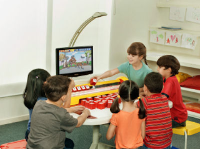Using Augmented Reality for Learning
 Augmented Reality (AR) is an enhanced version of reality created by the use of technology to overlay digital information on an image of something being viewed through a device like a smartphone or a camera. An AR system generates a composite view for the user that is the combination of the real scene viewed by the user and a virtual scene generated by the computer that augments the scene with additional information. The goal of Augmented Reality is to create a system in which the user cannot tell the difference between the real world and the virtual augmentation of it.
Augmented Reality (AR) is an enhanced version of reality created by the use of technology to overlay digital information on an image of something being viewed through a device like a smartphone or a camera. An AR system generates a composite view for the user that is the combination of the real scene viewed by the user and a virtual scene generated by the computer that augments the scene with additional information. The goal of Augmented Reality is to create a system in which the user cannot tell the difference between the real world and the virtual augmentation of it.
In the past, until 1990s, this technology was like a fantasy of scientists. The software was complicated; the equipment was expensive and heavy. Now with the usage of mobile devices and smartphones, there are many applications of AR and is used in many areas. Today augmented reality is used in many fields such as medicine, manufacturing, advertising, military and entertainment. One of the well-known applications of AR is the “Google Glass”. Even though it is not finalized and offered for sale yet, Google has started to promote the product. Google Glass is a wearable computer with an optical head-mounted display. It displays information in a smartphone-like hands-free format that it can interact with the Internet via voice commands. In the near future we will see people wandering around with these glasses.
It is hard to forecast how Google glass and similar tools will affect our lives but it is for sure that they will change the way we live. A short film called “Sight”comments on this rising technology’s potential impact on our lives and it is worth watching.
As mentioned above AR is also used for entertainment. Some performers use AR technology during their shows. One of the best examples of such usage I have seen is a magic show performed by Marco Tempest, who is a magician and loves to use technology in his shows. He performs his trick with a deck of card and his illusion glasses.
The YouTube ID of http://www.ted.com/talks/marco_tempest_a_cyber_magic_card_trick_like_no_other.html is invalid.Today AR is also used for learning especially in the fields of medicine and military. With AR learning there are no costs for making mistakes and errors, as they are not real. This is particularly promising in the training of flying a plane or doing a surgery.
These training experiences could be enlarged to many other fields. In the future AR can be a more widely used training method like e-learning or mobile learning and this process has already begun. For instance BMW Company uses augmented reality for training purposes. Engineers are equipped with eyewear that overlays virtual information specific to procedure used in the construction or repair of their automobiles.
As another example; Audi uses augmented reality to train its buyers. By using Audi’s application you can aim your iPhone camera at various parts of your Audi car. The application then identifies the parts in augmented reality and offers relevant information for that particular part. In other words the application converts your smartphone into a detailed user manual.
If you want to create your own AR experience, there is a great smartphone application called “Aurasma”. Both businesses and users use Aurasma to create and share their own AR experiences as well as discover hidden digital content around them. Teachers and schools are among the most active users of the platform. For instance the Heritage Elementary School in Texas uses Aurasma for their teaching garden. There are various points around the garden where students can unlock additional digital information and learn more about the plants in the garden. Another example is the University of British Columbia (UBC) who integrated Aurasma into the official UBC application. While reading the printed UBC viewbook you can use the application to unlock the images and videos hidden in the document. For a detailed demonstration of Aurasma you can watch the TED talk by Matt Mills.
The YouTube ID of http://www.ted.com/talks/matt_mills_image_recognition_that_triggers_augmented_reality.html is invalid.Augmented Reality has great potentials in education and training. The examples in this post only represent the beginning. We have a long way to go.
Resources
Aurasma. Retrieved 08 22, 2013, from Education: http://www.aurasma.com/category/education/
eLearnMagazine. Retrieved 08 22, 2013, from http://elearnmag.acm.org/featured.cfm?aid=2380717
Mashable. Retrieved 08 20, 2013, from http://mashable.com/category/augmented-reality/
TED. Retrieved 08 22, 2013, from Aurasma: http://www.ted.com/talks/matt_mills_image_recognition_that_triggers_augmented_reality.html
Youtube. Retrieved 08 20, 2013, from Google Glass: http://www.youtube.com/watch?v=v1uyQZNg2vE
Youtube. Retrieved 08 21, 2013, from Sight: http://www.youtube.com/watch?v=lK_cdkpazjI